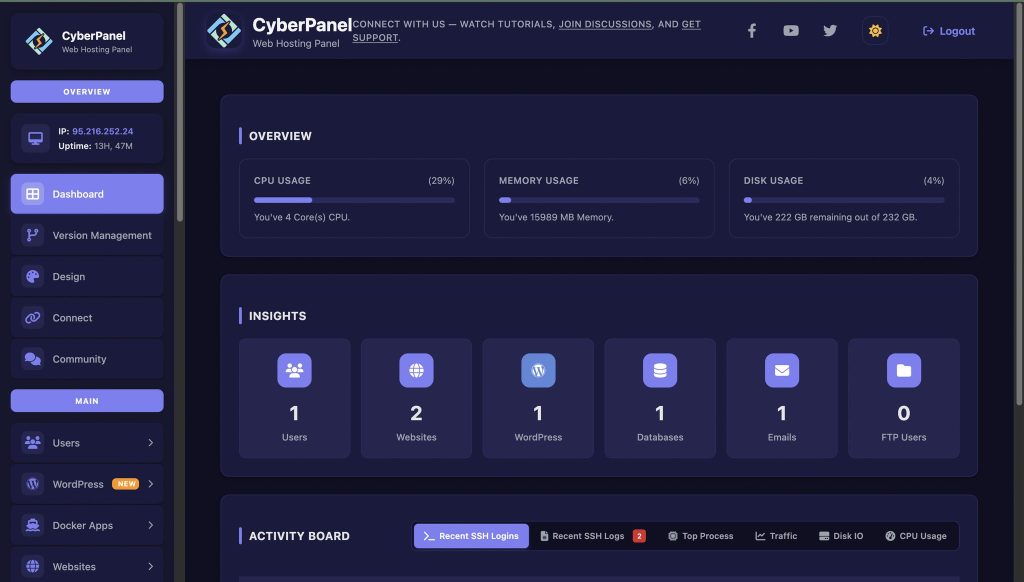Linux Peppermint is one of the most practical and user-friendly of Linux distributions today. Targeted at users seeking enhanced performance, speed, and stability, Peppermint Linux OS offers the best mix of cloud-based simplicity and local desktop control.
Originally, it was designed for running on older hardware. But Peppermint has transformed itself into a powerful, modern desktop system that is ready for new as well as experienced Linux users. Peppermint uses little system resources, which allows it to run without performance issues on older low-end systems. Moreover, it is an operating system that can provide practical and useful functions and UI polish, as Ubuntu and Fedora can do.
Whether you are a Windows user switching to Linux or just getting started, Peppermint Linux provides a straightforward desktop experience with fewer distractions and a general clean design that invites usage. The distribution is XFCE-based with elements of LXQt to help balance a polished experience with performance.
This complete guide will talk about Linux Peppermint OS, how to install it, software features, Linux Peppermint OS system requirements, and the comparisons of Linux Lite vs Peppermint. When you finish this article, you will know why Peppermint is still one of the fastest, most efficient Linux distributions for regular computing.
What is Peppermint OS Linux?
Peppermint Linux OS is a lightweight and user-friendly Linux distribution built on Debian and Devuan. Peppermint is designed for a fast and efficient desktop experience without any of the additional bloat.
Unlike a lot of Linux distributions, Peppermint OS combines your web-based applications as well as desktop software seamlessly from the desktop. Peppermint uses a site-specific browser tool called ICE, in which you can turn any website or web-based application into a stand-alone shortcut on your desktop.
Get exclusive access to all things tech-savvy, and be the first to receive
the latest updates directly in your inbox.
If you use web apps like Gmail, YouTube, and Google Docs and want the freedom, privacy, and control of a Linux OS, the Peppermint OS is a good choice.
Why Should You Consider Using Peppermint Linux?
Here are some of the popular benefits users have of using Linux Peppermint over other lightweight distributions:
- Speed: Boots quickly and runs smoothly on older hardware.
- Simplicity: A clean interface makes it easier for newer users to transition from using Windows and other distributions.
- Cloud Integration: Easily access cloud-based web apps by way of ICE.
- Low Resource Usage: A lightweight desktop consuming little RAM and CPU.
- Customization: Users have complete control of themes, icons, and layouts.
How to Download and Install Peppermint Linux
Here are the steps to download and install Peppermint Linux:
Step 1: Download Peppermint Linux ISO
Go to the official site, and click Peppermint Linux Download. You will have the latest ISO image, which can be placed onto a USB.
Step 2: Create a Bootable USB
Use an application such as Rufus (on Windows) or Etcher (Linux/macOS) to make your USB bootable.
Step 3: Boot from USB Drive
You will need to restart the system and choose the USB drive as a boot source.
Step 4: Install Peppermint Linux OS

You will need to follow the prompts to install Peppermint Linux. You will choose your language, how to set up partitions, and your username and password.
Step 5: Reboot
After installation is completed, just remove the USB and reboot your computer to your new Peppermint desktop environment.
Peppermint Linux OS Features You Will Love
- Hybrid Cloud Design: Run your web apps and your native apps fluidly.
- XFCE + LXQt Interface: A light, modern user experience.
- ICE Tool: An integrated tool that converts your web apps into icons on your desktop for easier access from the Peppermint Menu.
- Customizable: Requests for changing the wallpapers, panels, icons, editors, and themes for easy customization.
- Security: Based on Debian Linux and actively developed, meaning there is rarely an issue in relying on adding your commonly used applications and additional sandboxes.
System Requirements for Linux Peppermint
| Component | Minimum | Recommended |
|---|---|---|
| CPU | 1 GHz single-core | 2+ GHz dual-core |
| RAM | 1 GB | 2–4 GB |
| Storage | 10 GB | 20 GB SSD |
| GPU | Integrated Graphics | OpenGL 2.0+ compatible |
| Architecture | x86_64 | x86_64 |
Verdict: Peppermint is perfect for low-end laptops, older desktops, or lightweight virtual machines.
Customizing Peppermint Linux for Productivity
You can change a lot with Peppermint:
- Change Your Desktop Themes:
Go to Appearance > Style to change to a modern GTK-type theme. - Panel Tweaks:
Right-click on the bottom panel to add applets, launchers, or clocks. - Use ICE for web apps:
Use ICE to pin your favourite websites, including Gmail or YouTube.
This makes Peppermint Linux OS perfect for hybrid users who want the power of a desktop with a simple web-driven environment.
Best Uses of Peppermint Linux
- An old type of system for low-spec PCs.
- A cloud-based system as a workstation for remote teams.
- An old type of fast system in classes or offices, when speed and simplicity matter most.
- A developer’s minimalist system for coding.
- A quick testing environment to start and run installation tests on a VM.
Linux Lite vs Peppermint: Which is Better?
| Feature | Linux Lite | Peppermint Linux |
|---|---|---|
| Base | Ubuntu LTS | Debian/Devuan |
| Performance | Lightweight | Ultra-lightweight |
| User Interface | XFCE | XFCE + LXQt |
| Target Users | Windows switchers | Lightweight OS lovers |
| Web Integration | Limited | Built-in via ICE |
| Customization | High | High |
| Memory Use | 500–600 MB | 350–450 MB |
If you prefer cloud and web app integration with minimal resources, Peppermint Linux wins. However, Linux Lite might feel more familiar to Windows users.
How to Update and Maintain Peppermint Linux
Keep your Peppermint installation secure and stable using simple commands:
Update System Packages:
sudo apt update && sudo apt upgrade -yRemove Unused Packages:
sudo apt autoremove
Check Disk Usage:
df -h
Common Issues and Fixes in Peppermint Linux
1. Missing ICE tool:
If ICE doesn’t appear, reinstall using:
sudo apt install ice2. Wi-Fi not connecting:
Run the following to fix drivers:
sudo apt install firmware-linux
3. Slow boot:
Disable unnecessary startup applications under Session and Startup Settings.
Function of CyberPanel within Peppermint Linux

Though Peppermint is billed as a light desktop OS, it is effective on local development servers.
With CyberPanel, a web hosting control panel, you can:
- Deploy websites with OpenLiteSpeed.
- Run Docker containers with a GUI.
- Manage databases, SSL, and domains efficiently.
- Create local WordPress test environments.
Combining Peppermint Linux and CyberPanel gives you a powerful yet lightweight development setup for fast project deployment.
Final Thoughts!
Linux Peppermint OS is a strong candidate for users who want a desktop environment that is fast and stable and incorporates some degree of integration with the cloud. Peppermint has a special ICE tool, a very light footprint, and a slick XFCE + LXQt interface that together create a very compelling and user-friendly Linux distribution.
Whether you need to revive an old laptop, build a web-based workstation, or have a minimal setup for development work, Peppermint Linux gives you the confidence that everything will be fast and reliable.
Are you ready to experience the speed of Peppermint Linux? Download now and see for yourself why thousands of users have described Peppermint as the most refreshing light distribution for today’s modern computing environments!
People Also Ask
Is Peppermint Linux suitable for beginners?
Yes, it’s one of the easiest Linux distros for newcomers, with a Windows-like layout and low learning curve.
Does Peppermint support 32-bit systems?
No, newer versions only support 64-bit architecture for better performance.
Can I install Snap or Flatpak apps on Peppermint Linux?
Yes, both package managers can be installed manually to extend app availability.
Does Peppermint Linux support gaming?
Basic and cloud-based games work fine, but it’s not optimized for heavy gaming.
Can I dual boot Peppermint with Windows?
Yes, Peppermint supports dual booting alongside Windows or other Linux systems easily.



